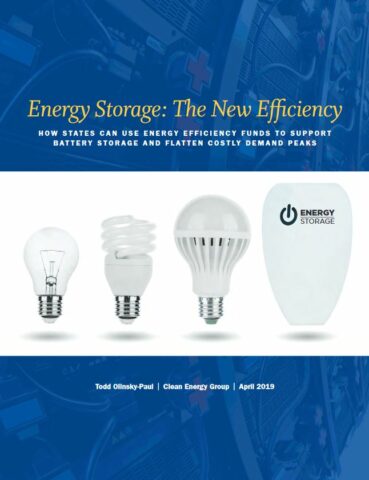Energy Storage: The New Efficiency ― How States Can Use Efficiency Funds to Support Battery Storage and Flatten Costly Demand Peaks
Massachusetts, a national leader in energy efficiency, has incorporated energy storage as an active demand reduction measure in its 2019-2021 energy efficiency plan. Clean Energy Group has prepared a report describing the process of enabling use of state energy efficiency funds to support the deployment of energy storage with performance incentives offered for demand reduction. This groundbreaking action was supported with original economic analysis by the Applied Economics Clinic, under contract to Clean Energy Group. The report, “Energy Storage: The New Efficiency ― How States Can Use Efficiency Funds to Support Battery Storage and Flatten Costly Demand Peaks,” explains the steps Massachusetts took to become the first state to integrate energy storage technologies into its energy efficiency plan, including actions to 1) expand the goals and definition of energy efficiency to include peak demand reduction, and 2) show that customer-sited battery storage can pass the required cost-effectiveness test. The report summarizes the economics of battery cost/benefit calculations, examines key elements of incentive design, and makes recommendations for other states to follow the example of Massachusetts and incorporate storage into their own efficiency plans. The report also introduces seven non-energy benefits of batteries, and for the first time, assigns values to them. The four appendices included with report provide detailed economic analyses, including two new white papers from Applied Economics Clinic that are being released contemporaneously within the report; and it offers recommendations to Massachusetts on improving its demand reduction incentive program in future iterations of the energy efficiency plan. The report comprises two parts: the first section, intended for a more general audience including state policymakers and regulators, explains the policy background, summarizes the economic analyses, identifies key barriers and issues, and makes policy and program recommendations. The second section, intended for a more technical audience, presents an independent cost/benefit analysis of customer-sited battery storage, reviews the economic underpinnings of the new Massachusetts storage incentive within the efficiency plan, and presents new analysis valuing seven non-energy benefits of battery storage. This report was made possible by the generous support from Barr Foundation and the Merck Family Fund.
Associated Project(s):
Resource Details:
Date: April 4, 2019
Type: Report
Topic(s): Energy Storage

